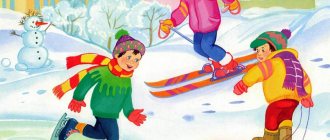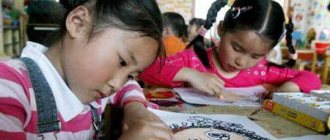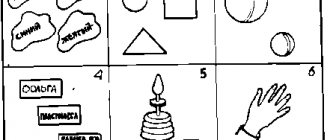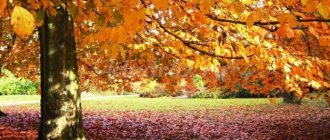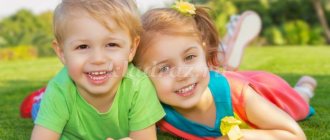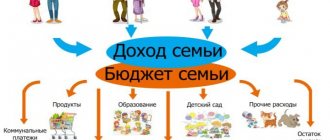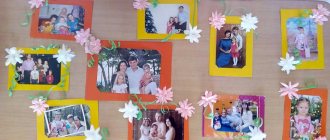Summary of a lesson on writing a story based on the plot painting “Family”
Anastasia Panfilova
Summary of a lesson on writing a story based on the plot painting “Family”
Educational: to develop children’s ability to understand the content of the picture ,
notice details; encourage a coherent and consistent description of the depicted events,
telling in compound and complex sentences;
developing: develop the ability to compose a story collectively , encourage you to invent events preceding the events depicted; activate vocabulary:
nouns – mother, father, grandmother, grandfather, children, family ;
verbs – live, work, rest, clean, knit;
adjectives – affectionate, gentle, kind, beautiful, beloved, dear, the oldest, the youngest;
adverbs – amicably, cheerfully, quietly.
Looking at the painting “Our Family ”
, conversation on it, reading fiction by V. Oseeva
“Just an Old Lady”
, P. Voronko
“Help Boy”
.
Drawing notes my family senior group
Content
Notes on drawing “My Family”
Goal: - to teach children to draw a human figure, to achieve a clear image of proportions, expressiveness of posture - to develop imagination, a sense of color, and an aesthetic attitude towards close people around them; the ability to reason, compare, draw conclusions, develop memory. — cultivate respect, a sensitive and caring attitude towards others and members of your family. — while drawing, maintain posture, encourage them to actively perform movements during physical education. Materials and equipment: Landscape sheets of different sizes, colored pencils, simple pencils, felt-tip pens, paints and other visual materials, sippy cups, brushes, napkins. OOD progress: Game “Studying parts of the body” Children, today we have guests, let’s say hello to them - I suggest you guess the riddle: Very wise grandfathers, Two beautiful grannies. Dad, my mommy -
This is all my (family).
- Absolutely right - this is a family.
— What do you think the word “family” means? (Children's answers) Family is a home, mom, dad, grandparents and children. Family is people who love each other, care about each other, help, feel sorry for each other, sympathize, treat each other with respect, speak to each other kindly .
-Please take everything in the mirror, look at yourself in the mirror. - Who do you think you look like? -Dasha, who do you think you look like? -Who do you look like, Kira? -And Bogdan, who do you look more like, dad or mom? — You look like your brothers and sisters, mothers and fathers. - Guys, why do we need a family? (Children's answers) - Guys, please pay attention to the exhibition of your family photographs! (draw the children’s attention to the stand with photographs). -Why do we call these photographs family photos? — You and I saw family photographs, however, there were no cameras before. How could your great-grandmothers capture their family in ancient times? (on canvas, painting).
-Children, I suggest you draw your family. To make it easier for you to learn how to draw, I will show you how easy it is to draw a person. A person has a round head - draw a circle. Short neck - draw a vertical line. Now I draw a horizontal line - this is the line of the shoulders, it is wider than the head. Now I’ll draw a longer vertical line - this is the line of the body, it is equal to the size of two heads. Below I will draw the line of the hips, it is equal to the line of the shoulders. Now I will draw a line of arms obliquely from the shoulders to the line of the hips. From the line of the hips we draw the lines of the legs; they are longer than the torso. This is how a man turned out. If you are drawing a girl, then draw a dress for the girl, if a boy, then draw trousers and a shirt.
Before you get started, let's play a little.
4.Dynamic pause (2 min.)
“Physical school One, two, three, four, (claps hands) Who lives in my apartment? (shrug)
One, two, three, four, five (claps hands) I can count them all. (arms to the sides) Dad, Mom, brother, sister, (bend one finger on both hands) My goldfinch, cricket and me - That’s my whole family. (clench and unclench fists
5. Practical part (Classical music sounds) - Guys, I suggest you choose any visual material with which you will draw today (paints, felt-tip pens, colored pencils, wax crayons) Please remember your family. Everyone who lives with you.
(When drawing, pay attention to the proportions of the human body.)
6.Final part/Reflection (3 minutes)
-What did we draw today?
-Who did you portray? What did you draw with? Where does your family go?
-What did you like most? The drawings are displayed on the board. (P
schoolfiles.net
Progress of the lesson.
Children stand by the chairs, the teacher says: “Today we will talk about family .”
And now the one who correctly selects the signs and actions for the words will sit down:
Mom (what)
– smart, kind, caring, gentle, etc.
Mom (what is she doing)
– takes care of, cooks, washes, etc.
(Children sit on chairs.)
- Who knows proverbs about family ?
(Children name proverbs, the teacher helps.)
-Today I brought you an interesting picture and we will compose a story based on it .
Let's take a closer look.
-What name do you think can be given to the picture ? Why?
-Let's stop at the one that accurately conveys the content of the picture .
-Now name all the family .
-Who is the youngest or youngest?
-What time of day is shown in the picture ? Why?
-What do you think all the family members were doing before they all got together?
— What are you doing now ?
family is this (friendly, big, cheerful....)
-What is the mood of adults and children?
-And now let’s look at the picture carefully again and say where we should start the story .
(The teacher listens to the answers and chooses the most appropriate one.
The story is made up by everyone together , that is, one begins, the other continues,
And the third one finishes according to plan: first tell about what happened
Before the family got together , what are they doing now and is it good to live in such a
Family.)
(We listen to the story )
Game “Name it differently.)
The teacher throws the ball and names a family , and the child must throw the ball in response,
Sit down and call it another word.
Mom - mother, mother, mummy, etc.
And now, who wants to tell you about the picture ?
(Listen to 1-2 stories )
Summary of the lesson : today we talked about the family depicted in the picture ,
And I’ll ask you to talk to your mom at home about your family and draw everyone yourself
Family members , what do you do in your free time?
Compiling a story based on the plot picture “Red Summer Has Come” Goals: activation and updating of the dictionary on the topic; improving the skill of composing a story based on a plot picture; development of coherent speech.
“Compiling a story based on a picture, Tanya is not afraid of frost” Integrated educational areas: cognitive development, speech, social and communicative. Goal: development of coherent speech in children.
Integrated lesson in the preparatory group “Drafting a descriptive story based on the plot painting “Golden Autumn” Topic: Compilation of a descriptive story based on the plot painting “Golden Autumn”. Objectives: Continue to develop the ability to write a story.
Summary of educational activities for speech development in the preparatory group “Composing the story “Winter Fun” based on a plot picture” Goal: to develop the ability to compose a descriptive story based on a plot picture. Program content: consolidate children's understanding of winter.
Abstract of the educational activity “Composing a story based on the plot picture “Early Spring” Synopsis of direct educational activities with children of the preparatory group for school. Topic: Compiling a story based on a plot picture.
Summary of a lesson on speech development “Making a story based on a picture” Purpose: to teach children to compose a short descriptive story based on a picture. Objectives: introduce to domestic animals, learn to compare the rooster and.
Lesson summary on the topic: “Drafting a descriptive story based on the plot picture “Fishing” (senior group) Objectives: To cultivate the desire to compose a story based on the picture. Teach children to compose a story based on a picture, including the most accurate words in it.
Summary of GCD in the senior group. Composing a story based on the painting “Winter Fun” Lesson on cognitive development in the senior group Topic: “Composing a story based on the painting “Winter Fun” Program tasks: Exercise.
Compiling a story based on the plot of the picture “The Naughty Women” Program objectives: • Strengthen the ability to answer questions and compose short stories. • Learn to understand the main idea of the work.
Compiling a story based on the plot picture “Winter Fun” (integrated lesson in the senior group) Municipal budgetary preschool educational institution “Signalsky kindergarten “Pepke”, Cheboksary district of the Chuvash Republic.
Source
Lesson “My Family” in the middle group of a preschool educational institution
Nomination “Methodological work in preschool educational institutions”
The family is the first social institution that a child encounters in life and of which he is a part.
Unfortunately, there is a widespread opinion that there is no need for specially organized introduction of a preschooler to his family. If a child lives in a family, he will be able to become familiar with this phenomenon in everyday life. But I don’t agree with this opinion, since the family does not give an in-depth understanding of the family. Modern society needs to restore traditional values, including caring for the family and promoting a family lifestyle. The results of research conducted by philosophers, sociologists, social psychologists and educators in recent years are alarming: they are increasingly talking about the crisis of the family, and the prospects for the development of this social institution are assessed extremely pessimistically. Everyone knows about the demographic problems that exist in Russian society, that every year the number of not only single-parent families, but also dysfunctional families increases.
In preschool pedagogy, the family, as a rule, is considered as a social environment in which the family education of a child is carried out. A preschool educational institution traditionally provides assistance to parents in raising children in the process of interaction between teachers and families of students. (initiative)
GCD Cognition “My Family”
Integration of educational areas: “Cognition” (formation of a holistic picture of the world), “Artistic creativity” (drawing), “Socialization”, “Communication”, “Physical education”, “Health”
Types of children's activities : playful, productive, communicative.
Tasks:
- clarify and generalize children’s knowledge about the family, who their relatives are;
- form ideas about the composition of the family using photographs of the child’s family members;
- improve the ability to write a short story about your family,
- develop coherent speech, cognitive interests, logical thinking,
- cultivate love and respect for your family members.
Contents of organized children's activities
1. Organizational moment. Looking at the paintings “My Family”.
Assignment: list all the family members you see in the “Family” pictures. Tell us who is older, what they do, what they are interested in, how they spend their free time, etc.
2. Photo exhibition “My Family”. Children show photographs of their family, name family members and tell a short story from their lives.
3. Game “Say the opposite”.
Grandfather is older, and dad ... (younger).
Mom is younger, and grandmother is older.
Dad is taller and mom...(lower).
Dad is big, and son... (small).
4. Conversation.
The teacher explains that grandmother is father’s mother or mother’s mother; grandfather is dad's dad or mom's dad; a child (boy) for father and mother is a son, a girl for parents is a daughter; a boy is a brother for a sister; a girl is a sister to a brother.
The teacher shows a picture of a family and asks to show: brother, sister, dad's mom, dad's dad, daughter, son.
5. Reading poems about mother and grandmother.
Lesson "My Family". Compiling stories from family photographs
Galina Panina
Lesson "My Family". Compiling stories from family photographs
Lesson “MY FAMILY ”
TOPIC: Compiling a descriptive story based on the photograph “My Family ”
.
GOAL: To teach children to compose a story according to the teacher’s plan. Develop the ability to vividly, coherently, consistently describe incidents from the life of your family . Learn to form words using diminutive suffixes and select related words.
EQUIPMENT: painting “ Family ”
, family
photographs of children , didactic game “Who owns what”
.
Progress of the lesson:
- Guys, look at the picture I brought you today.
(place the picture on the stand)
-What will you call this picture? painting " Family "
.Why?
-Do you like to solve riddles?
-Now, I will ask you riddles, and you must guess who we are talking about.
tell a fairy tale at night .
-What can your grandmother do? (children’s answers, the teacher seeks complete answers)
Grandfather: He wears glasses, reads a lot of books, knows a lot of fascinating stories. He helps his grandmother: he goes to the store and the market, receives a pension and does not harm his grandchildren.
-What is your grandfather like?
Mom: They call her the very first, most beautiful word on earth. This is the most dear person to you.
-Who is this riddle about? (about mom)
-What kind words do you call your mother? (mom, mommy, mummy)
-And in the old days, mother was affectionately called mother. (repetition by children)
-And the last riddle.
Dad: He is strict, attentive, spends all his free time with you: he takes you to the circus, during vacation he takes the whole family out into nature .
- That's right, what can dad do? (cut down trees, play football, etc.)
-What is your dad like? (strong, brave, courageous)
- Guys, do you know what people close to you call? (if children have difficulty, the teacher helps them)
- That's right, they are called relatives or relatives.
-Tell me, who are brother and sister? (relatives)
-What about your cousin? (relative)
-And auntie is daddy’s sister, who do you want? (relative)
-And uncle is daddy’s brother? (relative)
Physical exercise: (finger gymnastics: children bend their fingers into fists)
This finger is grandpa
This finger is grandma
This finger is daddy
This finger is mommy
Together, a friendly family (children bend and unbend their fists)
-Today for class , I asked you to bring a photo of your family . I also brought a photo of my family and I want to tell you about it
Teacher's story "My family "
.
story according to plan:
1. How many people are in the family ? (name them)
2. Tell us about each of them : where he works, studies, what he likes to do in his free time.
3. What does your family when they get together?
4. Why and why do you love your family ?
- Guys, did you like my story ? Why?
-Who has questions for me? (answers children's questions)
-And now, you yourself will write a story about your family . (2-3 answers)
(Then the children quietly tell stories to each other )
Didactic game “Who owns what”
. (A word game in which children name 3 objects that belong to grandma, grandpa, mom, dad, brother, sister.)
-Do you guys know sayings about family ? (if they know, then name and explain)
-Listen to another saying.
Your family is your most faithful friends.
-Explain how you understand it. (Children's answers)
Summary of the lesson .
( stories are recorded to decorate the corner.)
Photo materials for the project “My Family ”
Entertainment script for the Day of Family, Love and Fidelity “My Family” My Family Entertainment for the Day of Family, Love and Fidelity. Goal: To instill in children love for their family and their relatives, respect for.
Summary of the lesson in the preparatory group “My family, the pedigree of my family” Topic “My family, the pedigree of my family” (preparatory group). Goal: fostering love and respect for family and friends, knowledge of one’s own.
"My cheerful family." Final open lesson for parents dedicated to International Family Day Progress of the final open lesson in the first junior group The lesson “My cheerful family” is dedicated to International Family Day. Musical director.
Summary of a lesson on speech development in the middle group “Composing stories using mnemonic tables” Goal: to teach children to compose a coherent story Program objectives: 1) Develop the ability to compose short stories using a mnemonic table, using.
Open lesson on speech development in the second junior group “Writing stories about toys” Objectives: To teach children to carefully examine objects, highlighting their signs, qualities and actions; learn to describe an object, write a short one.
Children's compilation of creative stories based on the plot picture "Saving the Ball" Children's compilation of creative stories based on the plot picture "Saving the Ball" Literature used: T. A. Sidorchuk, S. V. Lelyukh "Composition.
Master class for parents “Composing descriptive stories and riddles” “Composing descriptive stories and riddles” master class for parents A riddle is a metaphorical expression in which one object is depicted.
Source
Summary of GCD in the senior group on the topic “My Family”
Abstract of GCD in the senior group on the topic “My Family” on moral and patriotic education
Author: Kopnalina Irina Petrovna, teacher, MBDOU “Kindergarten No. 113 “Belochka”, Nizhny Novgorod
Goal: to expand children’s knowledge on the topic “Family”, to expand ideas about family relationships; evoke feelings of respect, love, and attentive attitude towards your loved ones; practice agreeing nouns with adjectives; develop speech, attention, memory, imagination. Materials for the lesson: a series of narrative paintings on the theme “Family”, pictures depicting various objects. Replenishing the dictionary on the topic: mother, father, grandfather, grandmother, daughter, son, brother, sister, granddaughter, grandson, parents, children, family, relatives, younger, older, caring, beloved, dear, young, old, attentive, affectionate , slim, smart, beautiful, etc. I. Organizational moment. II. The situation of viewing the painting “My Family”. Questions for children: - Who do we see in the picture? — All the people depicted in the picture can be called in one word. Which one? The teacher turns to the child: - Sasha, who can you name from your family? Who do you live with? - You have a big family? How many people do you have in your family? - Who is the oldest? Who's the youngest? - Do you have Brother or sister? - Whose son are you? - What work does dad and mom do at home? — Do you help your mom, dad, brother, sister at home? Do you need help from adults? Why? III. Speech didactic exercise Game “Whose? Whose? Whose? Whose?" The teacher shows pictures of objects, and the child names the object and says whose it is. — Whose shoes? (Mom's) - Whose tie? (dad) - Whose umbrella? (grandfather) - Whose glasses? (grandmother’s) Game “Choose a sign word” - Mom (which one?) - kind, affectionate, gentle, beautiful... - Grandmother (which one?) - caring, attentive... Grandfather, brother, sister, dad, etc. Dynamic pause We are sitting at a round table, Torso turns (4)
We drink delicious tea and pies.
Forward bends (2)
The whole family gathered at this hour.
Claps over your head (4)
Who in the family will we say now:
Claps in front of you and behind your back
Grandfather, grandmother, dad, mom, me,
Jumping on the left, on the right and on two legs
My little brother and sister,
Squats (2)
A also Vaska the cat, fish, parrot, -
Tilts left and right
We all have a lot of fun,
Jump on two legs
You sing along with us.
Step on the spot Game “Fourth Extra” The teacher shows the children a card with a picture of four objects, one of which is extra, and the children must explain why. Game “Assemble a picture” Children assemble from twelve fragments a whole image of family members in different emotional states. IV. Consolidating the concepts of family relationships The teacher asks to name the full name. each family member, home address, profession and place of work V. Summing up the GCD.
We recommend watching:
Summary of a lesson in the senior group with a compensatory focus for children with severe speech impairments Lesson on self-knowledge in the senior group Summary of educational activities in the senior group on the topic: “Expedition to the taiga” Summary of the lesson in the senior group on introducing children to the peoples of the Kama region
Similar articles:
Summary of a comprehensive lesson on familiarization with the outside world and development of speech “Wintering Birds” in the senior group of a preschool educational institution
Summary of an integrated lesson in the senior group on the topic: Russian nesting doll
Summary of a choreography lesson in the senior group
Summary of thematic music lesson in the senior group
Scenario for a musical themed lesson with preschoolers aged 5-6 years
Looking at the painting “My Family”
What for Galyamova
Looking at the painting “My Family”
Goals: educational: teach the skill of viewing a picture , clarify, systematize knowledge about the family , introduce role relationships in the family .
Developmental: development of coherent speech, thinking, visual attention, creative imagination.
Educational: to cultivate love for your loved ones, the desire to take care of them, the ability to listen to others without interrupting, to work and play in a team, to form a positive attitude in the classroom.
